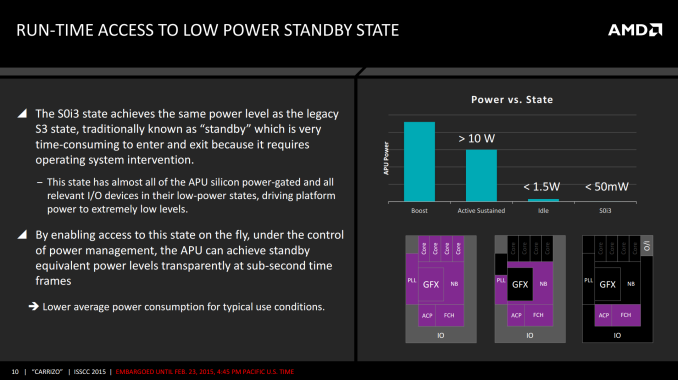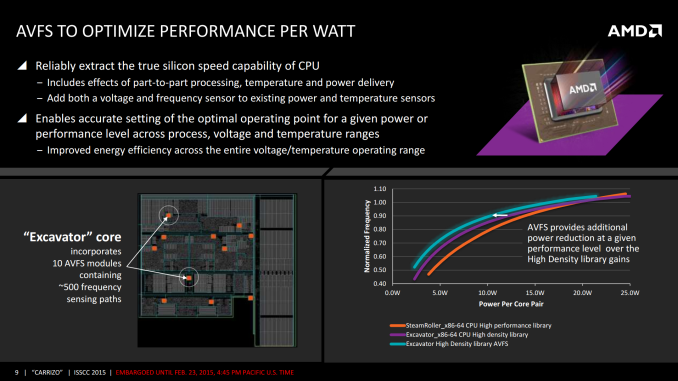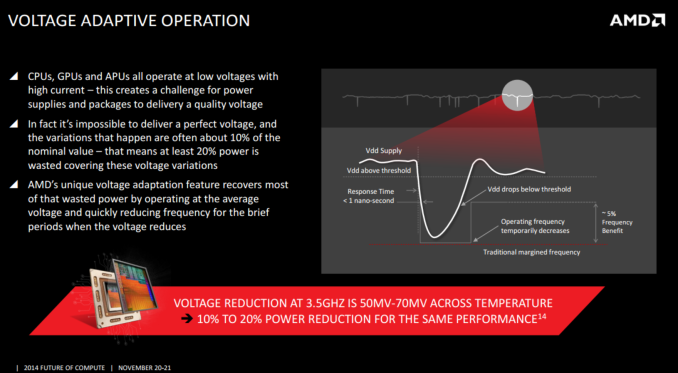AMD Launches Carrizo: The Laptop Leap of Efficiency and Architecture Updates
by Ian Cutress on June 2, 2015 9:00 PM ESTPower Saving and Power Consumption
When it comes to power, Carrizo features two/three technologies worth discussing. The first is the use of low power states, and the different frequency domains within the SoC. Previous designs had relatively few power planes, which left not as many chances for the SoC to power down areas not in use. Carrizo has ten power planes that can be controlled at run-time, allowing for what can be described as a dynamic race to sleep. This is bundled with access to the S0i3 power state, giving sub 50mW SoC power draw when in sleep and wake-up times under a second.
This is also combined with automated voltage/frequency sensors, of which an Excavator core has 10 each. These sensors take into consideration the instructions being processed, the temperature of the SoC, the quality of power delivery as well as the voltage and frequency at that point in order to relay information about how the system should adjust for the optimal power or performance point.
AMD states that this gives them the ability to adjust the frequency/power curve on a per-module basis further again to the right, providing another reduction in power or increase in frequency as required.
Next up for discussion is the voltage adaptive operation that was introduced back in Kaveri. I want to mention it here again because when it was first announced, I thought I understood it at a sufficient level in order to write about it. Well, having crossed another explanation of the feature by David Kanter, the reason for doing so clicked. I’m not going to steal his thunder, but I suggest you read his coverage to find out in more detail, but the concept is this:
When a processor does work, it draws power. The system has to be in a position to provide that power, and the system acts to restabilize the power while the processor is performing work. The work being done will cause the voltage across the processor to drop, to what we classically call Voltage Droop. As long as the droop does not cause the system to go below the minimum voltage required for operation, all is good. Voltage Droop works if the supply of power is consistent, although that cannot always be guaranteed – the CPU manufacturer does not have control over the quality of the motherboard, the power supply or the power conversion at hand. This causes a ripple in the quality of the power, and the CPU has to be able to cope with these ripples as these ripples, combined with a processor doing work, could cause the voltage to drop below the threshold.
The easiest way to cope is to put the voltage of the processor naturally higher, so it can withstand a bigger drop. This doesn’t work well in mobile, as more voltage results in a bigger power draw and a worse experience. There are other potential solutions which Kanter outlines in his piece.
AMD has tackled the problem is to get the processor to respond directly. When the voltage drops below a threshold value, the system will reduce the frequency and the voltage of the processor by around 5%, causing the work being done to slow down and not drain as much. At AMD’s Tech Day, they said this happens in as quickly as 3 cycles from detection, or in under a nanosecond. When the voltage drop is normalized (i.e. the power delivery is a more tolerable level), the frequency is cranked back up and work can continue at a normal rate.
Obviously the level of the threshold and the frequency drop will determine how much time is spent in this lower frequency state. We were told that with the settings used in Carrizo, the CPU hits this state less than 1% of the time, but it accounts for a sizeable chunk of overall average power reduction for a 3.5 GHz processor. This may sound odd, but it can make sense when you consider that the top 5% of the frequency is actually the most costly in terms of power than any other 5%. By removing that 5% extreme power draw, for a minimal performance loss (5% frequency loss for sub 1% of the time), it saves enough power to be worthwhile.













137 Comments
View All Comments
AS118 - Saturday, June 6, 2015 - link
I already signed up on the mailing list that tells you when Laptops with Carrizo come out and are ready to buy. You can do so on AMD's website if you're interested. The H.265 hardware decoding alone interests me, and all the other features like program-specific acceleration and the better GPU performance for mainstream games is nice.If you only play stuff like LoL or Counterstrike, or browser games or even older games on GoG and Steam, the A10 and up look like they'll be quite good.
ivyanev - Sunday, June 7, 2015 - link
As the performance is more than enough for everyday use, and the price is good, using it in mini PC would be great.watzupken - Thursday, June 11, 2015 - link
I was thinking the same thing. If they can produce this for use in those NUC sized PC, I will consider getting one as HTPC if the price is right.Fujikoma - Sunday, June 7, 2015 - link
AMD not including VP9 support is a mistake. They could always drop it if YouTube isn't as popular, but a lot of video in media articles tends to be linked to YouTube.It would be nice to see a die shrink with AMD adding more CPU cores to make up the difference to at least compete with Intel in number crunching.
ivyanev - Tuesday, June 9, 2015 - link
Try using h264ify plugin for chrome - it disables the vp8 and vp9 video, and youtube plays the mp4 versions - butter smooth and efficientfigus77 - Thursday, June 11, 2015 - link
I think everyone should look at APU with respect, apu is the future of pc and notebook, HBM on next AMD GPU will be a start and test for new APU with HBM on chip ram, that will be faster and faster than any ddr4 now available in market and probably any 'on motherboard' ram we will ever see, AMD could start a revolution in PC market, and other will probably copy them in short, even with faster cpu, but IF that will happens we shall be grate to AMD.And sorry for my english...
JDub8 - Tuesday, June 16, 2015 - link
Something I'm always interested in but is never addressed in these articles. The UVD playback and all its magical power savings - what codecs/players support it? If I have a CCCP installed will MPC-HC automaticall benifit? Or will that be reserved for some cyberpower payware dvd/bd player?